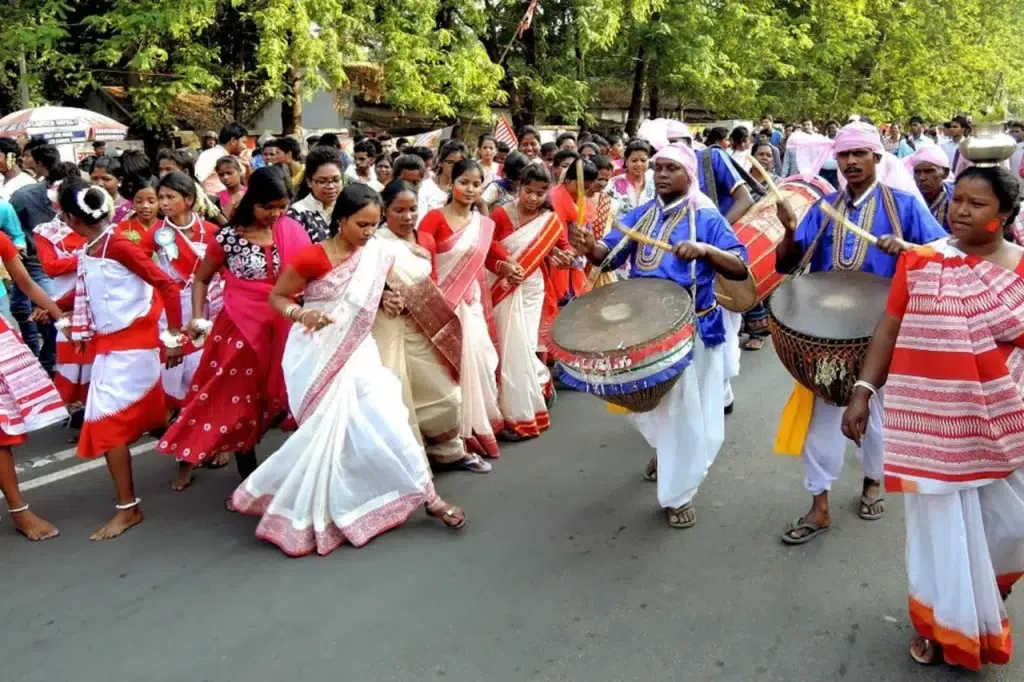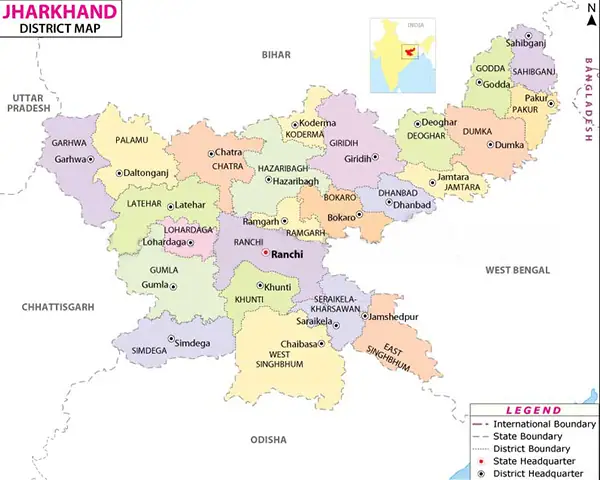Jharkhand Economic Survey 2020-21 : Chapter 1 Macro Economic Overview
Jharkhand is one of the low income states of the country. There is a great disproportion in the share of the state in turns of area, population and the income of the country. While, the geographical area of the state is 2.4 per cent of that of the country (2.5 per cent if we leave the areas occupied by Pakistan and China) and about 2.7 per cent of the population of the country lives in the state, its GSDP constitutes of only about 1.6 per cent of the GDP of the country.
Gross State Domestic Product (GSDP)
- The GSDP of Jharkhand has grown at an average annual rate of 5.9 per cent between 2011-12 and 2019-20.
- In the year 2019-20, it has been estimated to have grown at the rate of 6.7 per cent. The GSDP of Jharkhand constitutes only 1.6 per cent of the GDP of the country while it is spread over 2.4 per cent of the geographical area of the country and inhabits 2.7 per cent of the population of the country.
GSDP of Jharkhand in 2020-21 and 2021-22
- The COVID-19 pandemic has caused disruption in the national and the state economy. Because of the pandemic, the ensuing lockdown and the fear and restrictions caused it, the Gross Domestic Product of the country and its states contracted sharply in the first two quarters of the current financial year (2020-21). The sign of recovery, however, has become visible since October, 2020. The recovery is expected to take a V shape in the coming quarters.
- The real GSDP (GSDP at the constant prices) is expected to contract by 6.9 per cent and the nominal GSDP (GSDP at the current prices) is expected to contract by 3.2 per cent in the current financial year (2020-21). They are expected to recover in the next financial year.
- The real GSDP of the state is expected to record a growth of 9.5 per cent and the nominal GSDP of 13.6 per cent in the financial year 2021-22 over the GSDP of 2020-21. However, between the years 2019-20 and 2021-22, the annual growth rates would be only 1 per cent and 4.9 per cent, respectively, for nominal and real GSDP.
Per Capita Income
- The per capita income of Jharkhand in the year 2018-19 stood 26th among the 29 states of the country, ahead of only Manipur, Uttar Pradesh and Bihar.
- The per capita income of the state in the year 2019-20 is Rs. 57,863 at constant prices and Rs. 79,873 at current prices. Only three of the states of the country, namely Manipur, Uttar Pradesh and Bihar have per capita income which is less than that of Jharkhand.
Growth-Rate:
- Among the three major sectors of the state’s economy, the tertiary sector has grown at the fastest rate this year.
- Within the tertiary sector, the ‘Air Transport’ has recorded the fastest growth. It has grown at the rate of 31.7 per cent. ‘Trade and Repair Services’ is another sub-sector of the tertiary sector which has recorded an impressive growth. It has grown at the rate of 12.1 per cent in the year 2019-20.
- It is estimated to have grown at the rate of 7.9 per cent while the primary and secondary sectors have grown at the rate of 2.2 per cent and 4.9 per cent respectively in the financial year 2019-20.
- The tertiary sector has contributed the major share in the GSDP of the state (45.8 per cent) and is the chief contributor to the growth of the state’s economy also. It has contributed 62.5 per cent in the growth of the state’s economy in the year 2019-20. The primary and secondary sectors have made a contribution of approximately 9 and 29 per cent, respectively.
- Within the tertiary sector, the three sub-sectors – ‘Trade, Repair, Hotels and Restaurants’, ‘Real Estate, Ownership of Dwelling and Professional Services’ and ‘Transport, Storage, Communication and Services Related to Broadcasting’, have made major contributions to the growth of the state’s economy. Their contributions to the state’s growth-rate have been about 27, 14 and 9 per cent respectively. Thus about 50 per cent contribution to the growth of GSDP in the state has been made by these three sub-sectors.
Sectoral Shares in GSVA
- Between 2011-12 and 2019-20 the share of the tertiary sector, in the GSVA of the state has increased while that of the other sectors has declined. The shares of ‘agriculture, forestry and fishing’, ‘secondary’ and ‘service/tertiary’ sectors in GSVA of the state in the year 2011-12 were 16.1 per cent, 33.8 per cent and 38.5 per cent, respectively.
- In the financial year 2019-20 the share of agriculture in the GSVA is estimated to be 12.6 per cent while that of ‘secondary sector’ and services is estimated to be 32.8 per cent and 45.8 per cent respectively.
Inflation
- The rate of inflation in India and in Jharkhand has reduced after the adoption of the New Monetary Policy Framework in February, 2015. The rate of inflation in Jharkhand and India remained below 6 per cent in the financial years 2016-17, 2017-18 and 2018-19.
- For more than a year the rate of inflation in Jharkhand has remained above 6 per cent, the mark set by the RBI in its new monetary policy. It crossed the Reserve Bank of India’s (RBI) upper mark of 6 per cent in December, 2019. It has continued unabated since then.
- The rate of inflation in Jharkhand was 7.6 per cent in September 2020, 8.1 per cent in October, 2020 and 7.5 percent in November 2020. It is expected to reduce with an improvement in production and in the supply chain.
Poverty in Jharkhand
- According to the ‘Global Multidimensional Poverty Index -2019’ report, released by Oxford Poverty and Human Development Initiative (OPHI) and the United Nations Development Programme (UNDP), in July 2019, about 72 lakh people of Jharkhand have come out of multidimensional poverty in a ten- year- period from 2005-06 to 2015-16.
- The percentage of the multidimensionally poor in the state has decreased from 74.7 per cent in 2005-06 to 46.5 per cent in 2015-16.
Also refer :
- Top 50 Science MCQs For Competitive Exams
- Know About The Different Financial Sector Regulators In India
- For Jharkhand economic survey 2020-21 : Chapter 2, click here.





